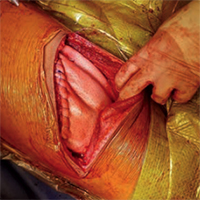The challenging management of a giant intrathoracic desmoid tumour: a case report

All claims expressed in this article are solely those of the authors and do not necessarily represent those of their affiliated organizations, or those of the publisher, the editors and the reviewers. Any product that may be evaluated in this article or claim that may be made by its manufacturer is not guaranteed or endorsed by the publisher.
Authors
Desmoid tumours are rare, locally aggressive neoplasms exhibiting high tendency for recurrence, even after complete resection. Only 1 in 5 of them originates from the chest wall, usually measuring less than 10 cm at diagnosis. Herein, we report the case of a woman presenting with symptoms of gradual lung compression by a giant desmoid tumour occupying the entire hemithorax. She underwent complete surgical resection of the tumour and chest wall reconstruction. She had disease recurrence 15 months later and currently remains under regular follow-up. The management of intrathoracic desmoid tumours is challenging because they are usually not diagnosed until they become large enough to cause compression symptoms. While medical management is the primary modality of treatment, surgery could be considered in selected cases where significant symptoms arise, and the functional status is impaired secondary to the tumour. Adjuvant radiotherapy to minimise the risk of local recurrence should also be considered.
How to Cite

This work is licensed under a Creative Commons Attribution-NonCommercial 4.0 International License.






